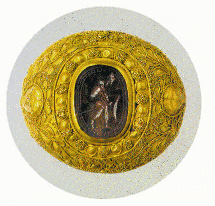 |
Gold Ring |
|
|
Jewellery from the Etruscan era is characterised by what seems to be the Etruscans sheer love of gold with its promising malleability and rich warmth of colour. The goldsmiths acheived an unrivalled level of skill in perfecting techniques such as granulation - the fusing of masses of tiny beads to the gold surface to create pattern and define forms. The history of Jewish wedding rings has been traced at least as far back as the thirteenth century, but the elaborately ornamented filigree rings were clearly not designed for wear. Used only during the marriage ceremony, they were placed on the brides right hand index finger after which they were kept by the synagogue.
the brief - a rich gold ring, bold scale, not precise but ancient feeling. Something like the rings she'd seen in a museum in Rome, dated 400BC. Combine this with the elaborate filigree detail of the traditional Jewish marriage ring pictured. the materials - 22ct gold. Only the highest carat golds have that rich luminous colour associated with ancient treasure. The downside is that the purer the gold the softer and heavier it is, jewellery from 22ct gold needs to be constructed from thicker material so as not to bend out of shape in normal wear. This ring is quite weighty, the wearer admits to having to take it off at night to avoid 'braining' her mate accidentally during sleep. Barbara Heath |
||
| catalogue home contact |
s |

